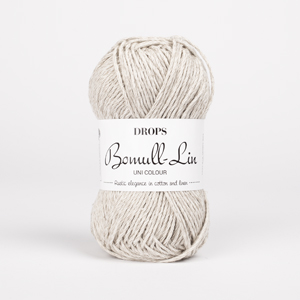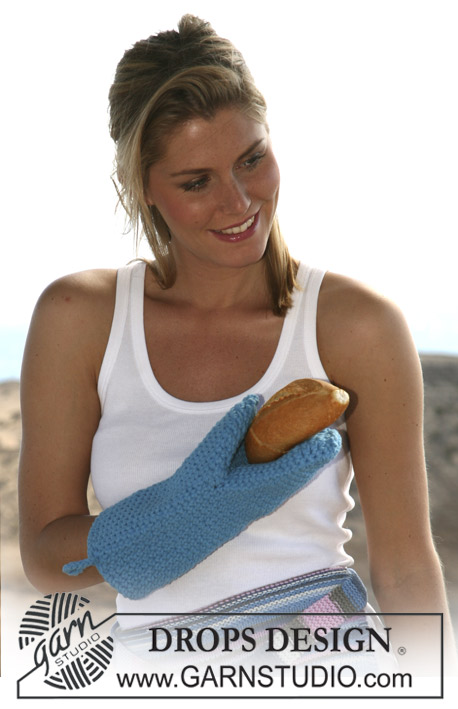Comments / Questions (53)
![]() Nadine Stadelmann wrote:
Nadine Stadelmann wrote:
Bonjour, après les 40 ms est-ce qu'on doit continuer d'intercaler un tour sans augmentation entre chaque tour avec augmentation ? d'avance merci.
07.11.2024 - 14:38DROPS Design answered:
Bonjour Mme Stadelamnn, quand on a 40 ms, on continue à augmenter, tous les tours cette fois, au même rythme qu'avant (on a juste 1 maille en plus entre chaque augmentation) jusqu'à ce qu'il y ait 88 ms après le 13ème tour (on augmente 8 m à chaque tour). Bon crochet!
07.11.2024 - 16:41
![]() Lesley HORN wrote:
Lesley HORN wrote:
As cotton viscose is discontinued what do you suggest as a substitute when crocheting a bread basket Drops pattern 107-30. Il
17.09.2023 - 15:39DROPS Design answered:
Dear Lesley, you can use DROPS Muskat as a substitute. Happy crochetting!
17.09.2023 - 21:31
![]() Paola wrote:
Paola wrote:
Buongiorno volevo fare il cestino per il pane. Leggo che occorre anche utilizzare DROPS Cotton Viscose di Garnstudio ma non trovo fra i filati
18.05.2021 - 08:04DROPS Design answered:
Buonasera Paola, purtroppo Cotton Viscose è un filato fuori produzione, ma può provare a sostituirlo con Safran o DROPS Loves you 7 o 9. Buon lavoro!
20.05.2021 - 22:02
![]() Eline wrote:
Eline wrote:
Har prøvd meg på brødkurven to ganger, med forskjellig fasthet. Begge ganger fikk bunnen en «hump» på midten, istedet for å bli flat. Hva gjør jeg galt? Hva kan jeg gjøre for å unngå dette?
04.08.2018 - 14:15DROPS Design answered:
Hei Eline. Det er fort gjort at den rette heklefastheten ikke blir overholdt, særlig når det er mange økinger. Prøv derfor å lage en hekleprøve der du har 15 fm i bredden = 10 cm. Det hekles med 1 tråd fra garngruppe A og 1 tråd fra garngruppe C, og arbeidet blir ganske stramt så det lett kan formes som en kurv. God fornøyelse.
22.08.2018 - 08:05
![]() Mette wrote:
Mette wrote:
Takk, det forstår jeg, men hva betyr 1 fm OM lm?
25.08.2016 - 15:47DROPS Design answered:
Hej Mette. At du hekler om lm. Se ogsaa denne video hvad forskellen er paa i eller om:
25.08.2016 - 16:03
![]() Mette wrote:
Mette wrote:
Hei. Jeg skjønner ikke setningen nedenfor i oppskriften på brødkurven, kan noen hjelpe meg? 1 fm om lm - hva betyr det? 2.omg: Hekle * 1 fm om lm, 1 fm i neste fm *, gjenta fra *-*.
25.08.2016 - 15:34DROPS Design answered:
Hej Mette. Det betyder at du skal gentage beskrivelsen mellem stjernerne (*-*) paa hele omg.
25.08.2016 - 15:40
![]() DROPS Deutsch wrote:
DROPS Deutsch wrote:
Ca. 16 cm Durchmesser und 14-18 cm hoch.
02.11.2010 - 10:40
![]() Clara wrote:
Clara wrote:
Welche Maße hat denn der Brotkorb ungefähr?
02.11.2010 - 09:58
![]() DROPS Design wrote:
DROPS Design wrote:
Hekler du for stramm eller for løs?
02.02.2010 - 08:45
![]() IMB wrote:
IMB wrote:
Jeg er i gang med å hekle brødkurven, men får det ikke helt til. Bunnen blir ikke en flat sirkel, men krøller seg. Hva gjør jeg galt?
01.02.2010 - 22:59
Provence Kitchen#provencekitchen |
|
|
|
|
Set comprise: DROPS ridge knit kitchen hand towel with loop in ”Bomull-Lin”, crochet bread basket in ”Bomull-Lin” and ”Cotton Viscose” and ridge knit pot holder with loop in ”Ice” or ”Bomull-Lin”.
DROPS 107-30 |
|
|
Ridge (back and forth on needle): 1 ridge = 2 rows garter sts. Kitchen hand towel: Cast on 58 sts on needle size 3.5 mm [US 4]. Knit ridges - see explanation above - until piece measures approx 40 cm [15,75"]. Knit next row with built in loop as follows: Knit until 2 sts are left on row. Before the last 2 sts cast on 9 new sts on row, then knit 2 last sts on row tog. On next row bind off all sts in garter sts (incl the new sts for built in loop). ________________________________________________________ Crochet DROPS bread basket in "Bomull-Lin" and "Cotton Viscose" Size: One-size Materials: DROPS Bomull-Lin from Garnstudio 100 g colour no 02 off white, or 03 linnen and use DROPS Cotton Viscose 100 g colour no 02 off white, or colour no 17 light beige DROPS Crochet hook size 4 mm [US G/6] - or the crochet hook you need to make 15 sc in width and 16 rows in height with 1 thread of each yarn quality = 4" x 4’. Bread basket: 1st round: Remember crochet gauge! Crochet 2 ch with 1 of thread of each yarn quality (= 2 threads) on crochet hook size 4 mm [US G/6]. Crochet 7 sc in 1st ch, finished sts with 1 sl st in 1st sc = 8 sc. Insert 1 marking thread (MT) or place marker (PM) at beginning of round. Continuing crochet in the round as follows: 2nd round: Crochet 2 sc in each sc = 16 sc. 3rd round: Crochet * 1 sc in first sc, 2 sc in next sc * repeat from *-* = 24 sc. 4th round: Crochet 1 sc in each sc = 24 sc. 5th round: Crochet * 1 sc in each of first 2 sc, 2 sc in next sc * repeat from *-* = 32 sc. 6th round: Crochet 1 sc in each sc = 32 sc. 7th round: Crochet * 1 sc in each of first 3 sc, 2 sc in next sc * repeat from *-* = 40 sc. Continue inc as follows on each round with 1 sc more between each inc until 13 rows are crochet in total = 88 sc. Continuing crochet 2 next rows as follows: 1st round: Crochet * 1 ch, skip 1 sc, 1 sc in next sc *, repeat from *-*. 2nd round: Crochet * 1 sc around ch, 1 sc in next sc *, repeat from *-*. Continuing crochet 1 sc in each sc until piece measures 5½"-7" measured from sc /ch round. Crochet 1 round with * 1 ch, skip 1 sc, 1 sc in next sc *, repeat from *-*. Cut and sew threads. Fold top edge double. ________________________________________________________ DROPS ridge knit pot holder with loop in "Ice" or "Bomull-Lin", Set comprises 2 pot holders. Measurement: Appr. 28 x 19 cm [11"x 7½"] Materials: DROPS Ice from Garnstudio 100 g colour no 02 off white, or 03 ice blue or: DROPS Bomull-Lin from Garnstudio 50 g colour no 02, off white 50 g colour no 03, linnen DROPS needles size 3.5 mm [US 4] – or the needle size needed to obtain correct knitting gauge 16 sts x 30 rows garter sts with 1 thread "Ice" or with 2 threads Bomull-Lin = 4" x 4’ Ridge (back and forth on needle): 1 ridge = 2 rows garter sts. Pot holder: For even coloured surface use Ice, for rustic surface use Bomull-Lin. Cast on 32 sts with 1 thread Ice or 2 threads Bomull-Lin on needle size 3.5 mm [US 4]. Knit ridges - see explanation above - until piece measures approx 7". Knit next row with built in loop as follows: Knit until 2 sts are left on row. Before the last 2 sts cast on 7 new sts on row, then knit 2 last sts on row tog. On next row bind off all sts in garter sts (incl the new sts for built in loop). |
|
Have you finished this pattern?Tag your pictures with #dropspattern #provencekitchen or submit them to the #dropsfan gallery. Do you need help with this pattern?You'll find 12 tutorial videos, a Comments/Questions area and more by visiting the pattern on garnstudio.com. © 1982-2025 DROPS Design A/S. We reserve all rights. This document, including all its sub-sections, has copyrights. Read more about what you can do with our patterns at the bottom of each pattern on our site. |
















































Post a comment to pattern DROPS 107-30
We would love to hear what you have to say about this pattern!
If you want to leave a question, please make sure you select the correct category in the form below, to speed up the answering process. Required fields are marked *.